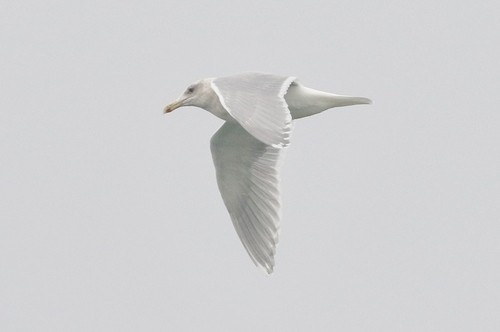Glaucous-winged Gull
A species of Gulls Scientific name : Larus glaucescens Genus : Gulls
Glaucous-winged Gull, A species of Gulls
Botanical name: Larus glaucescens
Genus: Gulls
Content
Description People often ask General Info
 Photo By silversea_starsong , used under CC-BY-NC-4.0 /Cropped and compressed from original
Photo By silversea_starsong , used under CC-BY-NC-4.0 /Cropped and compressed from original Description
This gull is a large bird, being close in size to the herring gull, with which it has a superficial resemblance, and the western gull, to which it is likely most closely genetically related. It measures 50–68 cm (20–27 in) in length and 120–150 cm (47–59 in) in wingspan, with a body mass of 730–1,690 g (1.61–3.73 lb). It weighs around 1,010 g (2.23 lb) on average. Among standard measurements, the wing chord is 39.2 to 48 cm (15.4 to 18.9 in), the bill is 4.6 to 6.4 cm (1.8 to 2.5 in) and the tarsus is 5.8 to 7.8 cm (2.3 to 3.1 in). It has a white head, neck, breast, and belly, a white tail, and pearly-gray wings and back. The ends of its wings are white-tipped. Its legs are pink and the beak is yellow with a red subterminal spot (the spot near the end of the bill that chicks peck in order to stimulate regurgitative feeding). The forehead is somewhat flat. During the winter, the head and nape appears dusky, and the subterminal spot becomes dark. Young birds are brown or gray with black beaks, and take four years to reach adult plumage. The glaucous-winged gull nests in the summer, and each pair produces two or three chicks which fledge at six weeks. It feeds along the coast, scavenging for dead or weak animals, fish, mussels and scraps. In urban areas it is well known for its tendency to accept food from people and peck open unprotected garbage bags in search of edibles. Its cry is a low-pitched "kak-kak-kak" or "wow", or a more high-pitched wailing. 
Size
61-69 cm (24-27 in)
Colors
Gray
White
Life Expectancy
15-22 years
Nest Placement
Ground
Clutch Size
1 - 4 eggs
Feeding Habits
Glaucous-winged Gull are opportunistic omnivores with varied foraging methods, eating invertebrates, fish, starfish, mollusks, small mammals, bird eggs and chicks, and scavenging remains from predators. They consume prey whole, rip from surfaces, or drop hard-shelled creatures to break shells. They also feed on fish spawn near shorelines and join seabird flocks offshore, and scavenge at landfills.
Habitat
Glaucous-winged Gull are coastal birds, inhabiting offshore islands, rooftops near shorelines, and coastal environments, including rivermouths, coves, and beaches. They favor areas with tidal pools for foraging during low tides. Consistently spotted at fish-processors and around fishing vessels for scrap feeding, glaucous-winged Gull are also known to scavenge inland at landfills with high tides, later returning to coastal areas for bathing and further foraging.
Nest Behavior
Both sexes of glaucous-winged Gull partake in selecting nesting sites and constructing the nest. They engage in nesting activities, including creating a scrape and building the nest together.
Nest Characteristics
Glaucous-winged Gull typically nest on ground level on rocky or grassy, treeless islands, occasionally on man-made structures. Their nests, which are rough in appearance, are constructed from grasses, weeds, moss, roots, twigs, string, and bones, measuring about 15.2 inches in diameter with an inner depression of 8.5 inches across and 4.2 inches deep.
Dite type
Omnivorous
People often ask
General Info
Feeding Habits
Bird food type
Sounds
Call
Recording location: United States
Call
Recording location: United States
Behavior
Glaucous-winged Gull engage in complex courtship rituals during spring, with established pairs showcasing condensed displays. They exhibit mate-feeding, where females gesture for food and males regurgitate nourishment. Pre-nuptial preening is common early in nesting season. Both parents share a combination of intricate greetings involving head-tossing and a unique 'choking' display when alternating incubation roles. Highly territorial, glaucous-winged Gull actively defend their nest and offspring with males detering intruders using threatening vocals and postures. Instances of fierce combat may erupt when rival males are repelled—engagements characterized by forceful pecking and wing beatings.
Species Status
Not globally threatened.